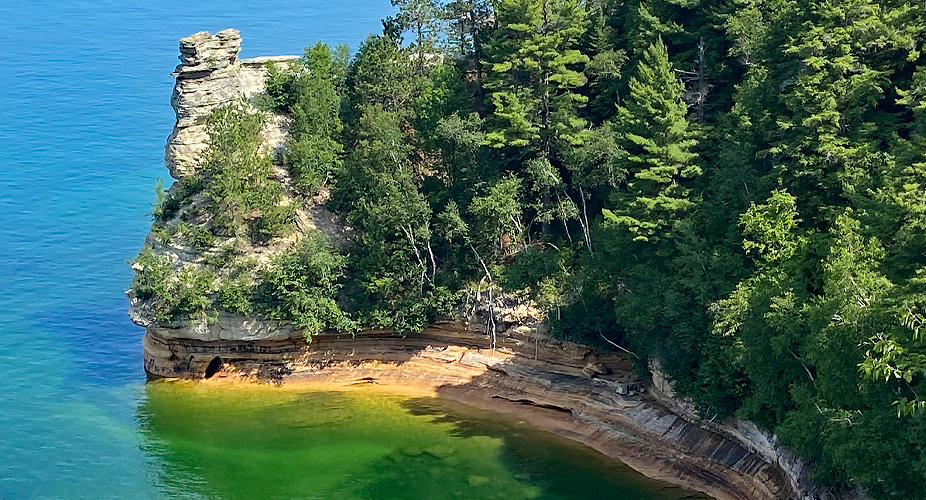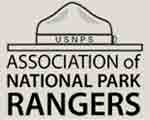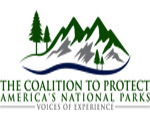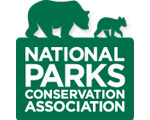|
National Park Service History Electronic Library & Archive
The NPS History Electronic
Library & Archive is a portal to electronic publications covering the history of
the National Park Service (NPS) and the cultural and natural history of the national
parks, monuments, and historic sites of the (U.S.) National Park System. Also included
are documents for national monuments managed by other federal agencies, along with a
collection of U.S. Forest Service publications.
The information contained in this Website is historical in scope and is
not meant as an aid for travel planning; please refer to the official
NATIONAL
PARK SERVICE Website for current/additional information. While we are not affiliated
with the National Park Service, we gratefully acknowledge the contributions
by park employees and advocates, which has enabled us to create this free
digital repository.
New eLibrary Additions
Featured Publications
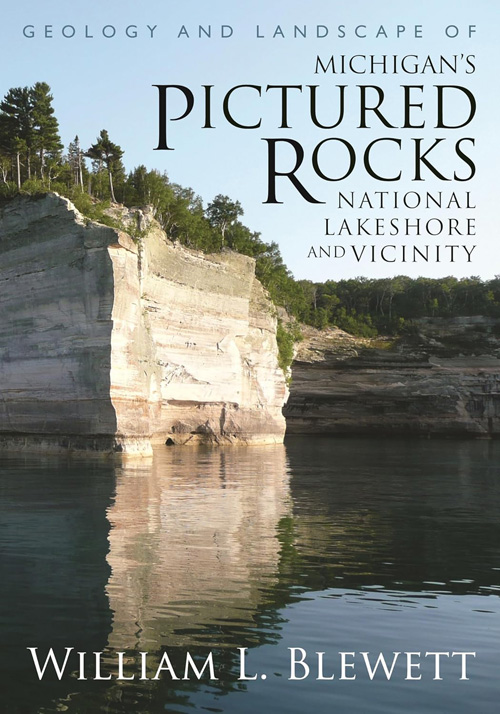 cover only Geology and Landscape of Michigan's Pictured Rocks National Lakeshore and Vicinity(William L. Blewett, 2012) |
|
Administrative History: Minidoka National Historic Site (Camille Daw and Bob H. Reinhardt, 2024)
Bones of Agate: An Administrative History of Agate Fossil Beds National Monument (Ron Cockrell, 1986)
Wright Brothers National Memorial: An Administrative History, 1968-1987 (Theodore Arden Amundson, 1987)
The Evolution of the Concept of Colonial National Historical Park: A Chapter in the Story of Historical Conservation (Charles E. Hatch, Jr., July 28, 1964)
Notes on the Establishment and Development of Chalmette Historical Park (Edward S. Bres, August 1964)
Unknown, Unnamed, Forgotten... The River Raisin American Dead: A Special History Study, River Raisin National Battlefield Park, Michigan (Shawna Lynn Mazur, 2025)
Cultural Landscape Report for the Nelson House Grounds, Colonial National Historical Park — Volume 2: Treatment (Danielle D. Desilets, 2024)
Fort Laramie and the Forty-Niners (Merrill J. Mattes, Rocky Mountain Nature Association, 1949)
Fishes of Glacier National Park Montana Conservation Bulletin No. 22 (Leonard P. Schultz, 1941)
Birds and Plants of Rocky Mountain National Park (Dean Babcock and Ruth E. Ashton, 1930)
The Monuments at Guilford Courthouse National Military Park, North Carolina (Thomas E. Baker, 1979)
Native American Tribes of the North Cascades National Park, Ross Lake National Recreation Area, and Lake Chelan National Recreation Area Contributions in Cultural Resource Management No. 14-1 (Allan H. Smith, March 1987)
Native American Tribes of the North Cascades National Park, Ross Lake National Recreation Area, and Lake Chelan National Recreation Area Contributions in Cultural Resource Management No. 14-2 (Allan H. Smith, March 1987)
Cultural Landscape Report: Erbie Rural Historic District, Buffalo National River (March 2024)
Brochure: Oregon Caves National Monument (1952; first park brochure to display the NPS Arrowhead logo)
Sentinel of Silence: A Brief History of Fort Spokane (David H. Chance, 1981, ©Pacific Northwest National Parks Association)
Mesa Verde National Park Historic Furniture Research Project (Patti Bell, August 2024)
Archeology of the Bynum Mounds, Mississippi Archeological Research Series No. 1 (John L. Cotter and John M. Corbett, 1951)
Archeological Excavations in Mesa Verde National Park, Colorado, 1950 Archeological Research Series No. 2 (James A. Lancaster, Jean M. Pinkley, Philip F. Van Cleave and Don Watson, 1950)
Archeology of the Funeral Mound Ocmulgee National Monument, Georgia Archeological Research Series No. 3 (Charles H. Fairbanks, 1956)
Archeological Excavations at Jamestown Virginia Archeological Research Series No. 4 (John L. Cotter, 1958)
The Hubbard Site and Other Tri-Wall Structures in New Mexico and Colorado Archeological Research Series No. 5 (R. Gordon Vivian, 1959)
Search for the Cittie of Ralegh, Archeological Excavations at Fort Raleigh National Historic Site, North Carolina Archeological Research Series No. 6 (Jean Carl Harrington, 1962)
From Marsh to Farm: The Landscape Transformation of Coastal New Jersey (Kimberly R. Sebold, 1992)
Historic Themes and Resources within the New Jersey Coastal Heritage Trail: Southern New Jersey and the Delaware Bay: Cape May, Cumberland, and Salem Counties (Kimberly R. Sebold and Sara Amy Leach, 1991)
Resorts and Recreation: an Historic Theme Study of the New Jersey Coastal Heritage Trail Route: The Atlantic Shore: Middlesex, Monmouth, Ocean, Burlington, Atlantic, and Capy May Counties (Sarah Allaback, ed., 1995)
Cavalry Clash in the Sandhills: The Battle of Monroe's Crossroads, North Carolina, 10 March 1865 (Kenneth Belew, 1997)
The projected exposure and response of a natural barrier island system to climate-driven coastal hazards (Jennifer A. Thomas, Patrick L. Barnard, Sean Vitousek, Li H. Erikson, Kai Parker, Kees Nederhoff, Kevin M. Befus and Mannochehr Shirzaei, extract from Scientific Reports, v14, October 28, 2024)
Reptiles and Amphibians of Zion National Park (Roland H. Wauer, 1964)
Assessment of Timber Resources and Logging History of the Valles Caldera National Preserve (Jeff Balmat and John Kupfer, December 28, 2004)
Best Practices for Managing Bank Erosion within the National Park Service and National Wild and Scenic River System NPS Science Report NPS/SR-2025/234 (John J. Field, Christina M. Leonard, Derek M. Schook, James M. MacCartney and Susannah O. Erwin, February 2025)
Exploring spatial patterns of overflights at Haleakalā National Park NPS Science Report NPS/SR-2025/224 (Bijan Gurung, J.M. Shawn Hutchinson, Brian A. Peterson, J. Adam Beeco, Sharolyn J. Anderson and Damon Joyce, February 2025)
Exploring Spatial Patterns of Overflights at Denali National Park and Preserve NPS Science Report NPS/SR-2025/220 (Brian A. Peterson, J.M. Shawn Hutchinson, Bijan Gurung, Davyd H. Betchkal and J. Adam Beeco, February 2025)
Spatial Patterns of Overflight at Bryce Canyon National Park, Updated 2023-2024 NPS Science Report NPS/SR-2025/242 (Tyra A. Olstad, Brian A. Peterson, J.M. Shawn Hutchinson, J. Adam Becco and Damon Joyce, February 2025)
Reporting Information for Commercial Air Tour Operations over National Park Units: 2021-2023 Report NPS Science Report NPS/SR-2025/235 (Meghan Ahearn, Amanda Rapoza and Ashley Pipkin, February 2025)
Fisheries Inventory at Rocky Mountain National Park to Inform Cutthroat Trout Conservation and Recreational Angling Decision Post-fire NPS Science Report NPS/SR-2024/157 (Yoichiro Kanno and Dan Preston, July 2024)
Climate and Species Traits Shape Responses of Alpine Flora in the US Rocky Mountains to a Changing World: Analysis of Five GLORIA Sties across the Southern Rockies NPS Science Report NPS/SR-2024/221 (Claire Powers, Erin Borgman and Daniel F. Doak, December 2024)
Three Decades of Ecological Change: the 2020 Saguaro Census — Part I: Changes in the Saguaro Population 1990-2020 (Kara O'Brien and Don E. Swann, March 2021)
Three Decades of Ecological Change: the 2020 Saguaro Census — Part II: Changes in the Plant Community (Emily Fule, Dan Beckman and Don E. Swann, December 2021)
Northern Harding Icefield Glacier Mass Balance Summary: 2010-2017 NPS Science Report NPS/SR-2025/240 (Deb Kurtz, February 2025)
Riverscape Interpretation in Great Basin National Park: A Geomorphic Assessment of Streams and Riparian Areas NPS Science Report NPS/SRA-2025/237 (Scott M. Shahverdian and Derek M. Schook, February 2025)
Paleontological Resource Inventory (Public Version), Mammoth Cave National Park NPS Science Report NPS/SR-2025/243 (Rickard S. Toomey III, Justin S. Tweet, Vincent L. Santucci, eds., February 2025)
Past vegetation dynamics in the Yellowstone region highlight the vulnerability of mountain systems to climate change (Virginia Iglesias, Cathy Whitlock, Teresa R. Krause and Richard G. Baker, extract from Journal of Biogeography, Vol. 45, 2018)
Community estimate of global glacier mass changes from 2000 to 2023 (The GlaMBIE Team, extract from Nature, February 19, 2025)
Sequoia Nature News Notes (1922-1936)
An Assessment of Stream Bed and Stream Bank Characteristics Within Pictured Rocks National Lakeshore Pictured Rocks Resource Report PIRO0 91-1 (Walter L. Loope and Michael P. Holman, December 1991)
Evidence of Physical and Biological Change Within the Beaver Lake Watershed Attributable to a Turn of the Century Logging Dam Pictured Rocks Resource Report PIRO 93-2 (Walter L. Loope, October 1993)
Peregrine Falcon Re-establishment Efforts Pictured Rocks Resource Report PIRO 92-1 (Brian C. Kenner, August 1992)
Use of Measurement Techniques and Management Standards to Define Acceptable Conditions in Backcountry Campsites at Pictured Rocks National Lakeshore, Michigan Pictured Rocks Resource Report PIRO 96-01 (Jennifer Anderson Torrey, January 1996)
Late Wisconsin History of Pictured Rocks National Lakeshore and Vicinity Pictured Rocks Resource Report PIRO 94-01 (William L. Blewett, October 1994)
Overview of Cambrian Sandstone Environments of Deposition Pictured Rocks Resource Report PIRO 97-1 (Robert Rose, 1997)
History of Fish and Fisheries in the Pictured Rocks National Lakeshore Pictured Rocks Resource Report No. 11 (John Vogel, 2000)
Fire and Vegetative Trends in the Northern Rockies: Interpretations from 1871-1982 Photographs General Technical Report INT-158 (George E. Gruell, December 1983)
Eastern and Southern National Forests (September 1932)
The Use of the National Forests (June 14, 1907)
A Primer of Forestry: Part I—The Forest U.S. Department of Agriculture Bulletin No. 24 (Gifford Pinchot, 1903)
A Primer of Forestry: Part II—Practical Forestry U.S. Department of Agriculture Bulletin No. 24, Part II (Gifford Pinchot, 1905)
Forest Reserve Manual for the Information and Use of Forest Officers (1902)
History of Packing in Idaho's Selway Country (Cindy L. Schacher, July 15, 2016)
Vanguard of Expansion: Army Engineers in the Trans-Mississippi West, 1819-1879 (Frank N. Schubert, August 1980)
NPS Reflections
|
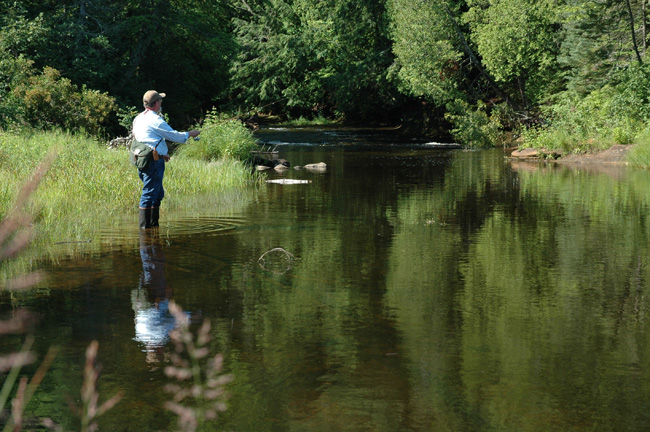
Fishing the Miners River (NPS photo)
HISTORY of FISH and FISHERIES in the
PICTURED ROCKS NATIONAL LAKESHORE
John Vogel
INTRODUCTION
Pictured Rocks National Lakeshore is situated on Lake Superior's
south shore, in Upper Michigan's Alger County. From the towering and
colorful sandstone cliffs east of Munising to the sand dunes and beaches
west of Grand Marais, the Pictured Rocks terrain embodies a variety of
contrasts. Nevertheless, consistent elements of that landscape are the
rivers, lakes and streams which flow, tumble and fall to Lake Superior
from the peninsula's nearby upland region.
A wide variety of fish inhabit these inland waters. Some that
historically resided in the area fell victim to human activities and are
no longer extant; others occupying the waters today are not native,
having been artificially introduced to the region. Therein lies the
purpose of this report. To promote an appropriate fish management system
within their boundaries, representatives of the Pictured Rocks National
Lakeshore deemed it necessary to study the history of the area's fish
and fish habitats. Specific issues to be investigated included the
following: the natural conditions that existed between Munising and
Grand Marais; the fish that were native to the area; the human
activities over time that may have affected the fish and their habitat;
and, finally, the fish culture propagation efforts that were practiced
to compensate for whatever environmentally detrimental activities may
have occurred. Among the specific bodies of water under study were the
following lakes: Beaver (Big and Little), Beaver Basin Ponds, Chapel,
Grand Sable, Legion, Miners, Sevenmile (historically known as Trout) and
Trappers (historically known as Perch). The following rivers and streams
were also components of this investigation: Chapel, Lowney, Hurricane,
Miners, Mosquito, Rhody, Sable, Section 34, Sevenmile, Spray and
Towes.
The Munising/Pictured Rocks area in Michigan's Upper Peninsula (U.P)
is included in the geological province known as the Eastern Ridges and
Lowlands. Among other features, the central U.P. portion of the area is
characterized by a ridge that separates the Lake Superior drainage
system to the north from the Lake Michigan system to the south. Since
the divide is relatively close to Lake Superior, north flowing rivers
are short, fast and frequently have waterfalls. Conversely, south
flowing rivers are much longer and slower.
Historically, the Pictured Rocks were an overwhelming natural
phenomenon, the cliffs, bluffs and waterfalls of which captured the
attention of virtually all who passed by on Lake Superior. No less
impressive, however, were the Grand Sable Dunes located immediately west
of Grand Marais. In fact, travelers from the east observed the dunes
prior to the Rocks. But the Pictured Rocks were the real object of
attention for travelers.
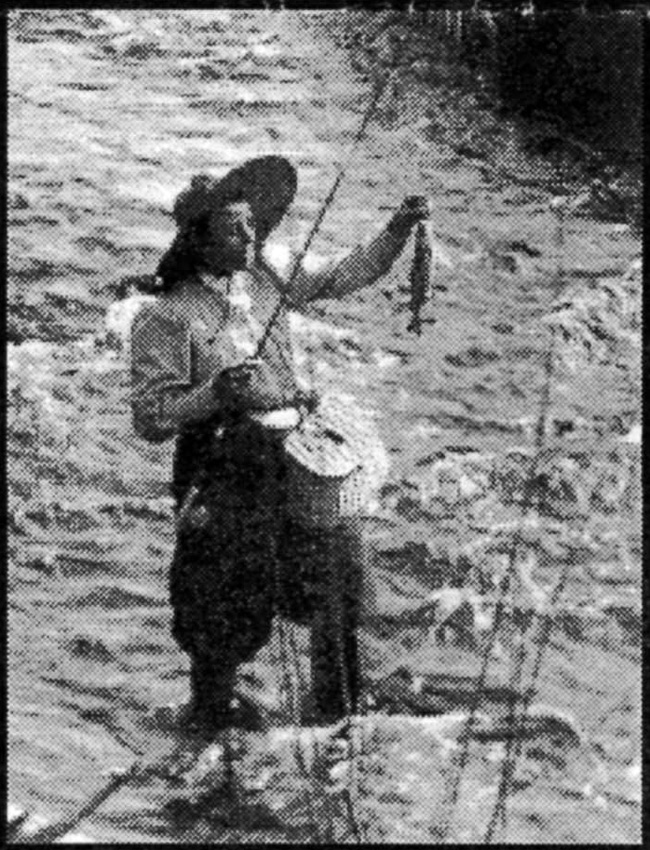
EARLY EXPLORATION
The magnificence of the topography notwithstanding, the waters
flowing inland to Lake Superior were also noticed by early travelers
along the south shore. Perhaps the most frequently described river along
the Pictured Rocks lakeshore was Miners River. Early descriptions of it
lack detail; however, they consistently agree that a small series of
rapids was found at the mouth. Several other waters running through the
Pictured Rocks were also described briefly prior to 1885—the year
this report has designated as the point when the natural condition of
the vicinity effectively ended. Chapel Creek was distinguished for its
fall of ten or fifteen feet as it entered Lake Superior, just as Spray
Creek was known as a "handsome stream, which is precipitated about
seventy feet from the bluff into the lake in one leap." Beaver Lake was
"a beautiful sheet of water, [with a] clear and sandy bottom." And in
1840, Grand Sable Lake was described as a "beautiful little lake," while
the river that flows from it to Lake Superior was characterized as a
"small, rapid stream...[that] looks muddy, being constantly filled with
the flying sand which it carries to the lake."
Even as the condition of the waters throughout the U.P. and along
Lake Superior varied in their natural state, most of them contained
fish, with the brook trout being the most commonly present and
consistently sought. Indeed, Robert Roosevelt wrote in 1865 that both
shores of Lake Superior are "one extensive fishing-ground. Virtually all
tributaries, to the lake, unless barricaded by falls," he wrote, "are
crowded with myriads of the speckled beauties." Another author suggested
in 1847 that "the thirty streams which run [into Lake Superior] from the
south, all abound in this superb fish, which vary from ten to forty
ounces in weight."
Given their reported presence throughout the peninsula, it is not
surprising that brook trout existed in many of the Pictured Rocks waters
currently under investigation. Although reports from the nineteenth
century were occasional at best, brook trout were known to be taken from
Miners River in 1840 and 1874. Trout were also taken at Chapel Beach in
1867; earlier, in 1840, trout were fished from the Twin River, just east
of Grand Marais. While brook trout were common in the rivers and
streams, they were typically not found in lakes unless, as it has been
suggested, coaster brook trout were simply passing through a lake to a
cold water stream. Miners Lake—the brook trout in the stream above
and below the lake notwithstanding—contained pike and yellow perch
in 1882, while Beaver Lake was known to have pike and bass.
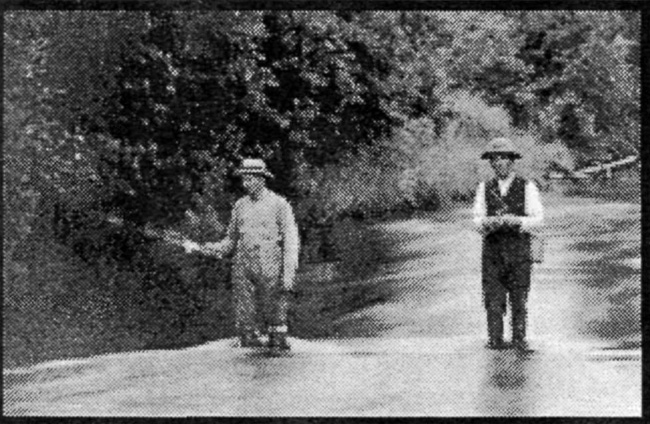
THE U.P. DISCOVERED
Throughout most of the nineteenth century, Michigan's U.P. was
largely unknown, despite the reputation of the Pictured Rocks lakeshore
and a few articles written by travelers. But as the 1890s approached,
the U.P. was about to trade its relatively natural and unspoiled
character for direct involvement with the developing recreation and
logging industries in the Great Lakes area.
By 1900, substantial changes had occurred throughout America, many of
which were attributable to the country's rapid post-Civil War
industrialization. Among the impacts of this phenomenon were overcrowded
cities. People living in expanding urban centers—and who had the
financial means—began to look for regions where they could
temporarily escape the devolving conditions. At the same time, large
numbers of Americans seeking economic independence through agricultural
success continued a pre-Civil War migration to the little-populated and
treeless prairies and plains west of the Mississippi River. To build
their new homes, they sought lumber.
These two divergent groups had something in common—Michigan's
U.P. Indeed, the region's natural environment offered the forests, clean
water, fish and game necessary to attract those looking for a
recreational respite from life in the city. Similarly, the forests and
water resources of the U.P. lured lumbermen who had exhausted their
timber resources in the East, yet, wanted to help supply the growing
market for lumber in the West. The combination of these activities in
the late nineteenth and early twentieth centuries had a dramatic impact
on the fish and fisheries of the U.P.
Regarding tourists, the desire to commune with nature was a growing
phenomenon manifested by the great wilderness camps of New York's
Adirondack mountains and the 1872 founding of Yellowstone National Park.
But key to the developing industry was the expansion of the railroad,
which provided transportation between cities and recreational spots.
Although the timber industry initially inspired rail construction in
Northern Michigan, railroad companies turned to tourism for revenue as
timber resources were depleted. The recreation industry was especially
successful in Michigan, which offered a wonderful site for rest and
relaxation. One of the major, earliest-developed tourist areas in the
U.P. was Mackinac Island. Yet, despite having been identified in 1874 as
a future sportsman's paradise with its "grand fisheries," the U.P. in
general experienced few incursions until the Detroit, Mackinac and
Marquette Railroad was built in 1882. With construction of that route
between Sault Ste. Marie and Marquette, tourists wasted no time
traveling to the northern portion of the peninsula. Passing close to
Munising, the railroad reportedly delivered in 1893 twenty tourists, who
planned to visit the area for a month. Furthermore, it was observed that
"the Beavers [the Big and Little lakes]" were a popular camp
location.
But accessing these sites was not simple because railroad
construction required large amounts of capital. Consequently, as soon as
a new line was opened for revenue service, railroad companies actively
sought to draw tourists and sportsmen to the area. In the case of the
road passing by Munising, the railroad pointedly remarked in a
promotional flyer that its line crossed many tributaries of the
Manistique and Tahquemenon rivers and their nearby lakes, all "teeming
with speckled trout, black bass, muskellunge, pike, pickerel and perch."
Regardless of such descriptions, no specific evidence was found to
chronicle the evolving number of sportsmen that came to the
Munising/Pictured Rocks area. Still, Columbus Hall, a regular camper in
the Beaver Lake vicinity from approximately 1900 to 1926, lamented in
1901 that "a great crowd of campers came down and we are crowded on the
right hand and the left. I am weary of so many strangers."
The number of recreationalists grew as the increasingly popular
automobile brought more sportsmen to Pictured Rocks from the 1910s
through the 1940s. Indeed, a public resort evolved near the
south/southeast shore of Beaver Lake around Lowney Creek. So-called
Burrell's Camp consisted of three cabins that offered amenities
including an ice box, wood-burning cookstove and kerosene cookstove; the
cabins rented for $35 per week—an amount considered high since no
meals were included. By 1960, this public resort had been transformed
into a private wilderness camp after the Michigan-Wisconsin Pipeline
Company acquired it as an executive retreat; it remained as such until
1974.
Given the natural beauty and seclusion of the Pictured Rocks area,
the region was viewed as a sanctuary by thousands who wanted to
escape—even briefly—the demands of rapidly growing cities and
industries. Ironically, however, the growth of those entities created
new demands for the very commodities that made the Pictured Rocks
vicinity an appealing retreat—especially lumber.
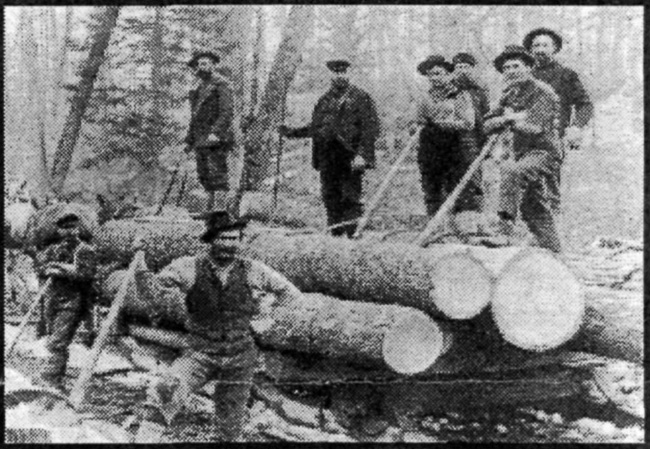
CATALYST TO CHANGE
Logging in the area was a local manifestation of an industry
established in the forests of New England during the early nineteenth
century and transplanted to the Great Lakes region during the 1850s,
once timber supplies in the East were exhausted. According to local
historian Faye Swanberg, logging in Alger County proper was initiated by
J.B. Weller in 1876. Thereafter, timber stands between Munising and
Grand Marais were "being cruised"; by the 1880s and 1890s, rafts of logs
were towed to mills along Lake Superior. By the 1920s, Swanberg noted,
Munising area mills handled a substantial amount of Pictured Rocks
timber that was cut in winter and driven on the streams in the spring to
dams adjacent to the lake.
Aside from the reference to timber "being cruised" during the 1880s
and 1890s, as well as a suggestion that the Beaver Lake area was logged
for the second time during the first years of the twentieth century,
there was no mention of logging by those touring the north shore area
between Munising and Grand Marais until 1901. At that time, Columbus
Hall observed both a dam on Beaver Creek located immediately downstream
from Lake Superior, as well as a boom of logs being towed on Beaver Lake
toward the river. Activity remained when Hall returned in 1902. Although
he made some references to loggers in the area during 1905 and 1906, no
other activities were identified until the early 1940s, when the efforts
of Guy Burrell were reported. Burrell cut timber on Beaver Lake for
several local Munising area concerns. When he was finished, he turned
his logging camp into a resort that was later sold to Robert Kennedy and
subsequently, to the Michigan-Wisconsin Pipeline Company. Burrell's
timber operation was but one instance of logging activities along the
various study area waters, including a venture on Chapel Beach. As well,
80 acres of hardwoods east of the Mosquito were allegedly logged in 1926
for the Charcoal Iron Company, while Miners River reportedly contained
three logging dams at one time.
Driven by a growing and industrialized nation and its demands for
lumber, charcoal and steel, the natural resources of the U.P. in
general, and the Pictured Rocks area in particular, were harvested to
excess. Indeed, the evolving recreation and lumber industries were
poised to have a dramatic impact on the fish and fisheries of the
region.
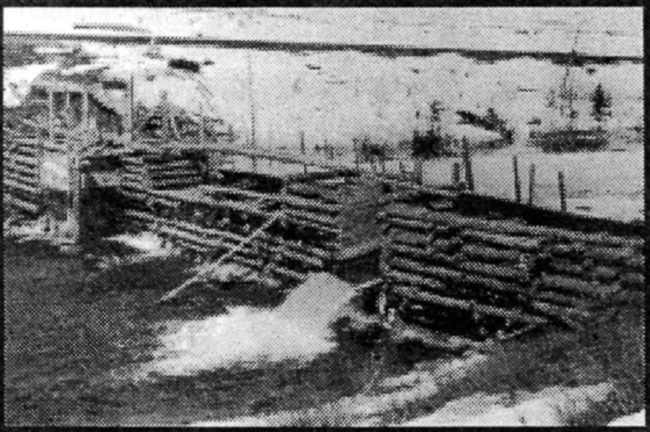
FISHERY DECLINE
As the Great Lakes forests were once thought to be inexhaustible, so
were the fish found in the waters of the U.P. Yet, reports of dwindling
catches throughout Michigan started to appear in outdoor publications as
early as the 1880s; the accounts focused more on Lower Peninsula waters
than those of the U.P. But an 1882 article indicated that trout fishing
was starting to fall off at Sault Ste. Marie, even though good streams
and rivers west of the Sault remained. The Sixth Biennial Report of the
State Board of Fish Commissioners ominously reported that by 1880, fish
in inland lakes, rivers and streams were being depleted generally by
poachers through the use of gill nets and explosives.
Despite poachers, a substantial amount of concern focused on
tourists, who simply wanted to catch as many fish as possible. Some
caught them with the intention of selling the fresh fish once they
returned home—a practice that the Michigan legislature declared
illegal beginning in 1915. Other concerns converged on the quantity of
fishermen utilizing Michigan waters. While this was initially a more
immediate problem for the waters in the northern half of the Lower
Peninsula, it would become a concern for the U.P.
Regarding the impact of logging on the Pictured Rocks fisheries,
Columbus Hall summarized it in general. When he returned to the Beaver
Lake area in 1901 after about a ten-year absence, he exclaimed, "I would
not have known the place, the timber being all cut off...." Indeed, the
impact of logging on a region's fisheries cannot be overestimated.
Specifically, a flowage's hydrology could be affected by logging and
removal of vegetation. For instance, the loss of pine and hardwoods
affects the overall evapotranspiration rates, which, in turn, can affect
the amount of water available for run-off. As well, logging-induced
sedimentation can fill pools and cover gravel river bottoms.
Furthermore, logging activities historically required the removal of
large wood debris, which otherwise, affected pools, promoted habitat
diversity, helped expose gravel bottoms, provided food and offered
cover—all of which were important to general fish habitat.
In addition to the general concerns about the impact of logging on
the region's fisheries, questions were raised about logging dams
specifically. A Forest and Stream editorial in 1889 clearly saw
dams as a threat to fish migration. Indeed, at one location on the Au
Sable River in the Lower Peninsula, not only could the fish not surmount
a logging dam, but they collected in the pool below, where they were
"speared, clubbed and netted by the wagon load." Further concerns were
raised about the artificial water surges created by the dams and the
potential these had to flush fish far downstream in the various
rivers.
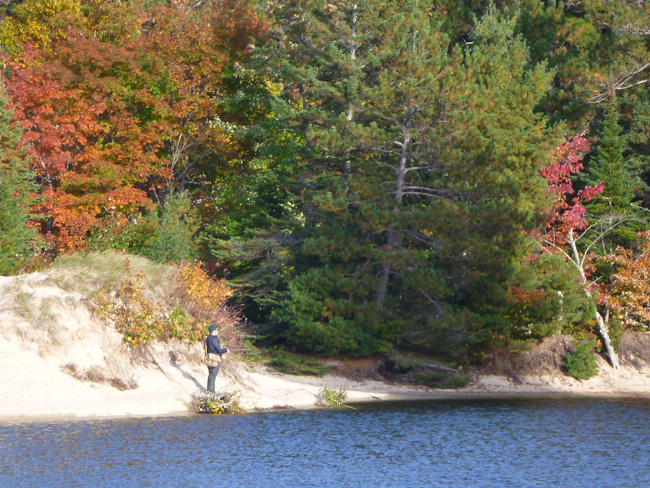
Fishing along the Miners River in Fall (NPS Photo/Reece)
HELP ON THE HORIZON
Concern about the fish population and how it was being threatened by
sportsmen and loggers led to various attempts at artificial propagation.
Early efforts involved the private activities of N.W. Clark and the
hatcheries he established in Oakland and Wayne counties in 1867 and
1874, respectively. Soon, the state itself became active in the process
as the Michigan Fish Commission was established in 1873 and began to
develop its own hatchery at Crystal Springs in Cass County. While early
state efforts to deal with declining fish conditions focused on the
Lower Peninsula, the portion of the state north of the Straits of
Mackinac quickly drew the attention of the commission. The first
discussion regarding a hatchery in the U.P. occurred in 1883. By the end
of 1884, land had been leased for a hatchery at Sault Ste. Marie. The
U.P. hatchery was expected to produce 2,000,000 brook trout annually, as
well as salmon trout, schoodic salmon and whitefish. The commission
predicted in 1885 that "the abundant success which has been attained in
the Lower Peninsula in the same kind of work enables the board to speak
with perfect confidence of what can be accomplished for the famous
streams of the Lake Superior region." By all accounts, the trial period
of the Sault Ste. Marie hatchery must have been successful because a
permanent facility was funded and built in 1894.
But hatcheries were only one element of a successful fish culture
program. Railroads were a vital component of the stocking process for
they created the network necessary to distribute fish across the state.
As well, Michigan's stocking program required the participation of
interested citizens. Prior to 1924, any interested party could apply to
receive trout for specific or favorite bodies of water. Accordingly, the
applicant had to meet the train, take custody of the cans containing the
fish, transport the cans to the water to be stocked, plant the fish and
then return the cans to the railroad station. With this process of
transportation and delivery, brook trout and whitefish were planted in
Michigan's inland waters and along the Michigan shoreline throughout the
1880s. The first plantings in Alger County occurred in 1892, when 30,000
and 6,000 brook trout were stocked in the Rock River (Au Train Township)
and Laughing Whitefish Creek (Onota Township), respectively.
State-sponsored stocking efforts aside, perhaps the most substantial
private initiative involved the Cleveland-Cliffs Iron Company, which
operated significant logging and mining activities in the U.P. William
G. Mather, the firm's president, was a conservationist. Thus, he and the
company were concerned about the deteriorating fisheries in the region.
Accordingly, Cleveland-Cliffs established a hatchery in 1904 that was
located about one mile south of Munising. Operating for eight years, the
facility initially raised brook trout, lake trout and salmon, all of
which were planted in the waters throughout the company's vast land
holdings. In 1904, the Cleveland-Cliffs hatchery planted 35,000 brook
trout and 9,000 salmon in Miners River, which appears to be the body of
water in the Pictured Rocks area most regularly stocked by the company.
Thereafter, fish were planted in Miners each year until the hatchery
closed in 1912. Perch Lake (Trappers Lake) was also stocked
regularly.
Over time, a new facet of the evolving debate about the state's fish
population and fishery conditions focused on the availability of rainbow
trout and other species for planting. Specifically considered was
whether non-native fish should be introduced—including those types
which, compared to native fish, might be better suited to the altered
environmental conditions of the state. For example, neither rainbow nor
brown trout was a native species to any Michigan waters. The former,
which was first planted by the state in 1880, was imported from
California; the latter came from Germany and was first stocked in 1885,
with the Michigan Fish Commission officially embracing the species in
1887. Other species planted over time included landlocked salmon trout
and Atlantic salmon; however, neither type ever developed a permanent
population.
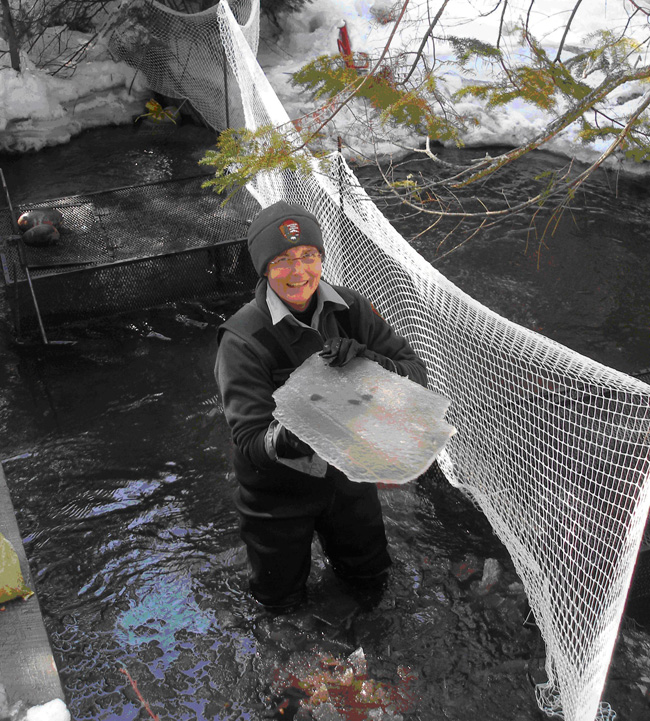
Non-native fish removal in 2009 (Jill Leonard/Northern Michigan University)
NATIVES vs. EXOTICS
An interesting dialogue about stocking non-native fish emerged in
various national publications. One contributor to Forest and
Stream argued that "in the stocking of inland waters, a grave
mistake has been made by the Fish Commissioners of more than one state.
Too great prominence has been given to certain game fishes, the
favorites of sportsmen and to fancy kinds from distant
localities....Another mistake has been the experiment...of putting
certain favorite kinds [of fish] into waters in which they had not
previously existed...instead of restocking indigenous species."
In contrast, a Forest and Stream contributor from Michigan
observed that the Grand Haven portion of the state offered great trout
fishing opportunities, despite the fact that trout were not native. But
because they were stocked, the state furnished a substantial
recreational opportunity where none would otherwise exist, given the
deteriorating character of the fisheries. Indeed, Forest and
Stream editorialized in 1907 that "in many waters it is a matter of
choice between other than native species, and in spite of the strong
sentiment in favor of our brook trout, there are waters in which he will
never again be found in any considerable numbers. The question,
therefore, resolves itself into one of introduced trout or none, and the
rainbow and brown trout are worthy successors to our dethroned favorite,
fontinalis."
There were also environmental issues to consider. As noted, logging
had a dramatic impact on the conditions of native trout waters because
tree cover was lost and water temperatures increased. While both the
brook and rainbow trout prefer cool water with a good current, the
rainbow will adapt to warmer water and survive quite well; the brook
will not. Additionally, the brown trout is adaptable to the changing
environment. A sportsman in New York wrote in 1907 that, since the brook
trout was disappearing, another fish had to be found to take its place.
He argued for the brown trout, suggesting that it "...is a splendid fish
and is suited to fill the place he is about to occupy."
Another environmental issue that should have been considered—but
apparently was not—regarded the compatibility of various species in
shared waters. Brook and rainbow trout were said to do relatively well
together as they coexisted in the Lower Peninsula's Au Sable River.
Nevertheless, larger rainbow competed with brook trout for food and
spawning beds. The brook trout, on the other hand, was dangerous to
other species in a body of water because, if it was hungry and the food
supply was low, the mature brook would eat other fish. This was the case
with the black bass. Consequently, many avid trout fishermen wanted to
keep black bass away from trout waters because once a bass is in a body
of water, it "...is there for all times, eating up every living thing
not larger than himself."

Mosquito River (NPS photo)
It was within this broad, developing context of Michigan's fish
culture that the various waters of the Pictured Rocks area were stocked.
Brook trout were the first fish to be planted in Pictured Rocks area
waters shortly after the turn-of-the-century. Raised in the state
hatchery system, they were planted in Chapel Creek between 1903 and
1905. Similarly, brook trout were planted in Miners River from 1904 to
1914, although this stock came from both the Cleveland-Cliffs hatchery
as well as the state facility. In 1904 and during 1908 through 1912,
respectively, salmon and steelheads from the Cliffs hatchery were also
planted in Miners River. Regarding other waters, brook trout were
stocked in Mosquito River in 1914. Largemouth bass were planted in
Beaver Lake in 1905, while Grand Sable Lake received smallmouth bass in
1908 and largemouth bass in 1910. Between 1907 and 1910, Trappers
(Perch) Lake was stocked with steelhead, lake trout, walleye, smallmouth
bass and landlocked salmon trout—all of which were produced by
either the state or Cleveland-Cliffs hatcheries. Additionally, rainbow
trout were planted in Sevenmile (Trout) Lake from 1908 to 1910.
Little or no planting occurred in the Pictured Rocks area from 1914
to 1934. During the latter year, bluegills began to be stocked in Grand
Sable Lake for the next eight years. From 1936 to 1942, Grand Sable also
obtained smallmouth bass, walleye, largemouth bass, pike, perch, black
bass and lake trout—all of which came from state hatcheries. After
an eight-year hiatus, stocking resumed at Grand Sable Lake in 1950, with
the planting of smelt. Over the next twelve years, rainbow were
primarily planted in Grand Sable.
Chapel Lake was planted with brook trout during the early and middle
1950s, while Legion Lake received brook almost yearly between 1935 and
1946. Brook trout were again stocked in Miners River in 1935, at which
time they were planted in the Hurricane River, Mosquito River and
Sevenmile Creek. Throughout the 1950s and into the 1960s, brook trout
were typically stocked in the Mosquito, Hurricane and Miners rivers and
in Sevenmile Creek. Although brown trout were observed in some Pictured
Rocks waters, a record of their planting did not occur until 1960, when
they were stocked in Lowney Creek. Additionally, brook were planted in
Lowney from 1948 to 1954.
A major innovation in the state's fish culture program came during
the 1960s, when the splake was developed. It was a hybrid fish developed
by crossing brook and lake trout. Along with brook trout, lake trout,
rainbow trout, walleye and largemouth bass, the splake was planted
periodically in Beaver, Grand Sable, Legion and Trappers lakes
throughout the 1970s and 1980s. At present, walleye and lake trout
continue to be planted in Beaver Lake and Grand Sable Lake,
respectively. Additionally, a three-year research project that
re-evaluates stocking programs under the park's Fisheries Management
Plan will be completed in 1999. According to the plan, future
stocking in park waters will focus on naturally reproducing populations
of native species.
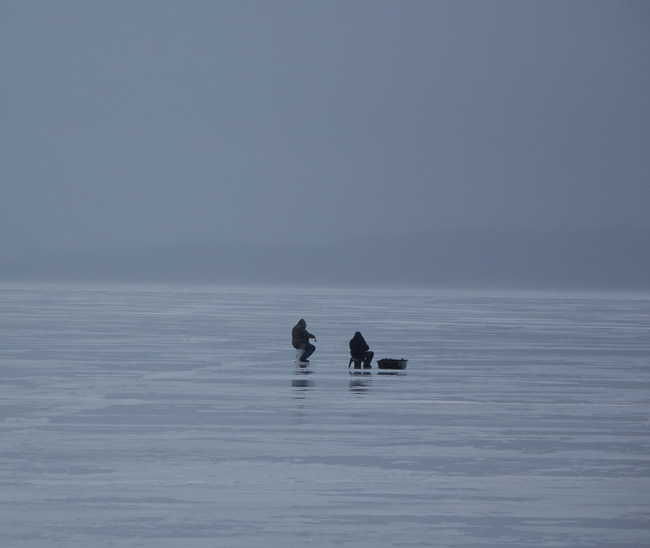
Ice Fishing on the Bay (NPS photo)
CONCLUSION
Today, conditions of the Pictured Rocks fisheries vary—as do the
explanations for those circumstances. Two local fishermen agree that
most trout waters in the park are declining; however, they offer
differing perceptions about particular waters. Their general concerns
focus on the impact of sea lamprey barriers, overfishing by tourists,
the predatory nature of some fish and the declining character of the
fish habitat. Contrasting the impressions of local fishermen to some
extent, several scientific opinions have been rendered. Reports
assessing the quality of the Beaver Lake fishery, for instance, note
that the body of water currently supports walleye, northern pike,
smallmouth bass, rock bass, yellow perch, brook trout and coho salmon.
Furthermore, no concerns regarding walleye feeding on other species were
noted; nor was there any mention of detrimental effects from logging
activities on the quality of the lake bottom. One issue upon which the
local fishermen and U.S. Fish and Wildlife Service personnel agree is
that overfishing accounts for many of the adverse conditions prevalent
in the Pictured Rocks area fisheries today.
In addition, several conclusions can be drawn from this study. It is
apparent, for instance, that brook trout were native to many of the
rivers and streams in the waters of the Pictured Rocks. As well, both
the recreation and logging industries had lasting impacts on the fish
population and its habitats. The study of Michigan's evolving fish
culture clearly indicates that rainbow and brown trout were not native
to the region, but that they were well suited to the waters of the area
and were able to adapt to the changing conditions of those waters in a
way that brook trout could not.
Consequently, the present condition of the fisheries is
mixed—over 100 years of attempting to sustain healthy fish habitats
and populations notwithstanding. Some of the difficulties are related to
the lingering effects of overfishing and logging; others are associated
with the well-intentioned experiments of game managers early in the
twentieth century. While the State of Michigan and National Park Service
have made—with some success—substantial commitments over the
years to rehabilitate and maintain area fisheries, regulatory safeguards
may well be needed to protect the modest advances.
Given the constantly evolving character of the landscape and
environment, however, it is not practical to believe that pre-1885
fisheries can be recreated. Nevertheless, it is important to understand
the nature of the early fisheries and which fish were native to them. It
is only when the historical conditions are understood and considered in
the context of environmental conditions today that an effective resource
management plan can be developed. Indeed, it must be a plan that builds
on the past, but that is focused on the future.
Text from Pictured Rocks Resource Report PIRO-2000-1, John Vogel — Heritage Research Services, 2000.
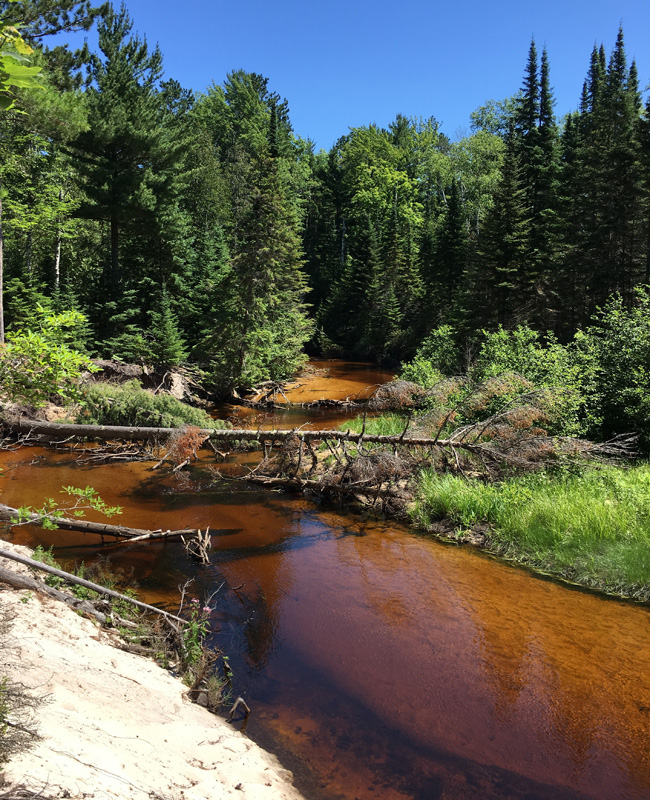
Miners River (NPS photo)
|
National Park Friends
|
Please Note: NPSHistory.com is an independent effort; we are not an
official partner of the National Park Service (NPS), though a
huge debt of gratitude is extended to all NPS employees (current
and former) and other park supporters who have graciously contributed
their personal collections, thus enabling us to present these rather
scarce documents for free public use. Due diligence has been employed in
scanning these documents in an attempt to ensure the accuracy of the
materials presented, however, we make no representations or warranties
of any kind about these digital documents. While most of the content
contained herein is in the public domain, the Website also contains
copyrighted works (permission to host this content is on file); please
respect the reserved rights of these copyright-holders. Use of this
Website is done so at your own risk; we are not responsible for
any loss or damage arising from information or links contained within
this site. Enjoy!
|
|

